
* The MiG-21 was originally built as a lightweight day fighter, but evolved over its life to acquire new roles -- such as that of all-weather interceptor and reconnaissance platform -- while growing more capable and, somewhat unfortunately, heavier, up to the final production variant, the MiG-21bis. This chapter provides a survey of single-seat Soviet-built MiG-21 main production variants. Two-seat trainers, Chinese MiG-21 clones, and experimentals are discussed in later chapters.
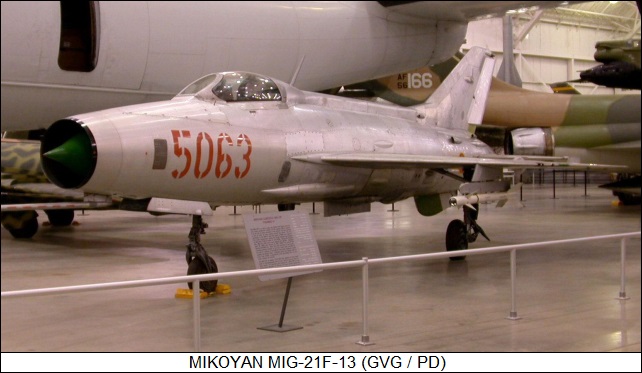
* The Korean War introduced jet aircraft combat to the art of warfare, and of course in the aftermath the USA and the USSR absorbed the lessons learned in the conflict. What pilots on both sides said was that they wanted more performance, in a lightweight, agile fighter that could outfly an opponent in a dogfight. The American response was the Lockheed F-104 Starfighter, but that is another story, told elsewhere.
In the period after World War II, Soviet jet fighter design had been dominated by the OKB (experimental design bureau) led by Artyom Ivanovich Mikoyan. The Mikoyan MiG-15 had been evenly matched with the US North American F-86 Sabre over Korea, and had led to the improved MiG-17 derivative. In the mid-1950s, much the same design concepts led to the twin-engine MiG-19, the first supersonic Soviet jet fighter to go into widespread service.
Even as the MiG-19 was going into operation, the Mikoyan OKB was working on a successor that embodied the lessons learned in Korea. A state requirement for a fast, light fighter had been passed down in the fall of 1953. The requirement was general in nature, providing broad specifications in the form of an aircraft with a top speed of Mach 2, armed with cannon and fitted with a radar gunsight, with the capability to carry guided air-to-air missiles (AAM) later.
Although other OKBs worked on the same requirement, some of them were too committed on other projects to seriously take on another design effort, and others were unable to provide designs that the authorities found acceptable. That left the Mikoyan OKB as the "last man standing", with a go-ahead for aircraft development granted by the authorities in January 1954.
* At the outset the Mikoyan design was given the OKB code of "Ye-1", where "Ye" stood for "Yedinitsa", meaning "single unit" and translating as "one-off special prototype". The Ye-1 was to be powered by a single Arkady Mikulin AM-5A axial-flow turbojet. However, changes were made immediately in the design. On analysis the AM-5A proved inadequate, and so the decision was made to fit the aircraft with the improved Mikulin AM-9B derivative engine, which powered the twin-engine MiG-19 fighter; this selection would quickly move on to the further improved Mikulin AM-11 engine, then in development and optimized for the fast light fighter requirement. The OKB code for the aircraft was updated to "Ye-2".
As was the custom in the Soviet aerospace industry, the aerodynamics of the Ye-1 were to be based on concepts suggested by the state Central Aerodynamics & Hydrodynamics Institute ("TsAGI" in its Russian acronym). Design decisions were complicated somewhat by the fact that TsAGI had provided a choice of two configurations. Both involved an aircraft that had a fuselage something like that of the MiG-19, with the intake in the nose, but slimmer, with a conventional swept tail assembly and mid-mounted wings. The wings were the differentiating factor between the two concepts: one envisioned strongly swept-back wings, with a sweep of 55 degrees at 25% chord and along the lines of the wings of the MiG-19; the other envisioned a pure delta wing with a leading-edge sweep of 57 degrees.
Another complication was that the desired AM-11 engine wasn't going to be available right away, so development would have to start using the existing AM-9B engine. Construction of six prototypes was quickly authorized:
Of course, the Ye-2 and Ye-4 were to be completed first, with the rollout of the Ye-2B and Ye-5 dependent on availability of the AM-11 engine. Construction of what would ultimately be three more prototypes designated "Ye-50" was also authorized at the same time: these machines were to have the swept wing, an AM-9B engine, and an integral liquid-propellant boost engine.
* The Ye-2 prototype was rolled out in early 1955 and performed its first flight on 14 February 1955, with Georgiy K. Mosolov at the controls. The flight went well enough, though Mosolov noted that it was underpowered. Of course that was expected given that it was fitted with the AM-9B engine, and it would still quickly prove capable of maximum speeds of Mach 1.8.
The first Ye-4 delta-wing prototype performed its initial flight on 16 June 1955, with Grigory A. Sedov at the controls. To the shock of the design team, the machine was only capable of a maximum speed of Mach 1.2. There was no difference between the Ye-2 and Ye-4 except for the delta wing, and TsAGI analysis suggested that the delta wing would be effective -- but it wasn't turning out that way in practice. The design team began a series of tinkerings with the wing design to see if it could be made to work. Gradually, performance began to improve.
The new AM-11 engine was suffering from development problems, being prone to fires and other troubles, and so the prototypes that were to use that engine were delayed. The first delta-wing Ye-5 prototype finally performed its first flight on 9 January 1956 with Vladimir A. Nefyedov at the controls, the flight taking place on the same day that the rocket-boosted Ye-50 prototype took to the air for the first time -- more on this below. The first swept-wing Ye-2A prototype performed its initial flight on 17 February 1956, with Sedov at the controls. The second Ye-2A prototype performed its initial flight on 4 September 1956, with Sedov at the controls. The second Ye-5 performed its initial flight before the year was out.
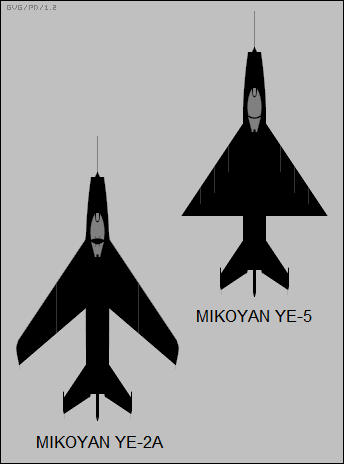
Trials of the Ye-2A and Ye-5 were so promising that by early 1956 the clear expectation was that one of them would be put into production, with the service designation of "MiG-23" being reserved for the Ye-2A and "MiG-21" for the Ye-5. Pre-production batches of the Ye-2A and Ye-5 were ordered, with each batch consisting of five machines. Intensive trials showed that while the Ye-2A was a good machine, in spite of the early developmental problems the Ye-5 turned out to be better, being more maneuverable, lighter, and slightly faster. Apparently due to its bad start, there was a certain amount of surprise when the Ye-5 was selected for further development, expected to lead to production. The MiG-21 was the future; the MiG-23 designation was set aside to be "recycled" in a later Mikoyan OKB fighter.
The West had already received hints about the new types of aircraft, with swept-wing and delta-wing prototypes performing a flyby in the course of the Aviation Day air show at Tushino Airport in Moscow on 24 June 1956. Very bad photographs gave the general configuration of the aircraft, with NATO assigning the swept-wing machine the reporting name of "Faceplate" and the delta-wing machine the name "Fishbed". It would take a few more years for the West to figure out which one was actually put into production.
* Initial prototype development was not quite finished, since the engine design bureau -- now under Sergei K. Tumanskiy, Mikulin having been given the boot in 1955 -- had got most of the problems with the AM-11 under control and was in fact offering an improved version. The AM-11 had become the R-11 with the departure of Mikulin, with the "R" standing for "Reaktivniy", or loosely "reaction (device) / jet engine" in English, and the new engine variant was the R-11F-300, with a considerable jump in afterburner power.
Three more delta-wing prototypes, designated "Ye-6", were ordered to evaluate the R-11F-300 engine. Initial flight of the first Ye-6 was on 20 May 1958, with Vladimir Nefyedov at the controls. It quickly proved impressive, handily breaking through Mach 2 in level flight, but unfortunately the aircraft was lost on 28 May. Nefyedov suffered a flame-out at altitude; he tried to restart but nothing happened, and he was ordered to punch out. He insisted on staying with the aircraft. He did make it back to the runway; unfortunately, with flight systems out of operation the aircraft came in on its back. He was alive when he was pulled from the wreckage, but died of his burns in the hospital.
Nefyedov's death was a shock to the OKB staff. The failure of his flight systems was due to the fact that the initial Ye-6 only had a single hydraulic system. The second Ye-6 was promptly torn down and rebuilt, through considerable effort, with dual hydraulic systems. It performed its first flight on 15 September 1958, piloted by Konstantin K. Kokkinaki -- the brother of Vladimir K. Kokkinaki, chief test pilot of the Ilyushin aircraft OKB. Performance proved as impressive as before, and the engine was starting to mature: 46 flights required only three engine changes!
The third Ye-6 performed its initial flight in December 1958. Trials were completed, with Kokkinaki concluding that the type could be flown by "any normal pilot", and the go-ahead was given for full production. Initial deliveries of the production "Ye-6T" or "MiG-21F" to the VVS (Voyenno Vozdushniye Sily / Red Air Force) were in the fall of 1959. It was also known by the factory code of "Izdeliye (Type) 72" or "I-72"; NATO would refer to this variant as the "Fishbed-B", the prototypes being referred to as "Fishbed-A" retroactively. Incidentally, the MiG-21 would not become popularly known by its NATO "Fishbed" name; everyone just called it the "MiG-21".
Production for the VVS was assigned to State Factory Number 21 in Gorkiy. Later on, the MMZ Znamya Truda (Banner of Labor) factory, once State Factory Number 30, was assigned to build export production.
* The two surviving Ye-6 prototypes continued in trials, and in a particularly interesting and significant exercise, the second prototype was used for trials in 1960 of a new Soviet weapon, a heat-seeking AAM.
Actually, it wasn't really a Soviet weapon. The USSR had been working on radar-guided AAMs and not paid much attention to heat-seeking missiles until September 1958, when Taiwanese North American F-86 Sabre fighters tangled with Chinese MiG fighters over the Formosa Straits. The Sidewinder proved effective against the MiGs, but a few of the AAMs scored hits, didn't detonate, and remained embedded in their targets. The missiles were disarmed and quickly reverse-engineered, with trials of the K-13 (service designation R-3S) AAM beginning in early 1959. It would be fielded, to be given the NATO reporting name of "AA-2 Atoll".
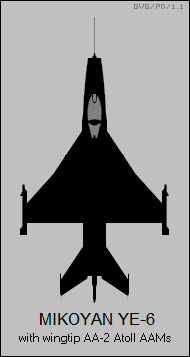
The initial K-13 fit on the second Ye-6 involved modifying the aircraft with new wingtips that featured a shallower sweep and an AAM launch rail on each tip. This scheme didn't work out, and so the actual fit would be to carry an AAM on a pylon under each wing.
The third Ye-6 was fitted with a souped-up R-11 engine and used to set speed records under the designation of "Ye-66" -- it was a Soviet custom to disguise such aircraft under an alternate designation as a security measure, and in fact such dodges did much to confuse Western knowledge of Soviet aircraft until after the fall of the USSR. In any case, on 31 October 1959 Georgiy Mosolov set a world's record over a straight-line 25-kilometer (15.5-mile) course of 2,504 KPH (1,556 MPH / Mach 2.36). On 16 September 1960, Konstantin Kokkinaki set a record for a 100-kilometer (62-mile) closed-circuit course of an average of 2,148.66 KPH (1,334 MPH).
* As a footnote to this section, of course the rocket-boosted Ye-50 was a dead end. As mentioned, the first of the three prototypes performed its initial flight on 9 January 1956, with test pilot Valentin G. Mukhin at the controls. It was much like the Ye-2, except for the addition of a Dushkin S-155 liquid-fuel rocket motor in the tail, burning storable propellants and driven by compressed nitrogen gas, with the rocket exhaust above the jet engine tailpipe.
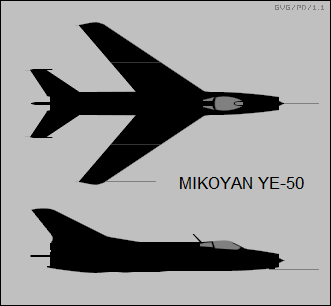
The initial flight was performed on turbojet power only, with the first flight that lit the rocket motor on 8 June 1956, but the initial prototype was damaged beyond repair in a rough landing on 14 July and written off. The other two Ye-50s followed in 1957, though one was lost after an inflight fire or explosion in the fall of that year; the pilot, N.A. Korovin, ejected, but did not survive the accident.
By that time, the Ye-50 program was running out of steam anyway. Things had seemed to go well at the outset, with performance meeting expectations, and there were preliminary plans to build two "MiG-23U" evaluation aircraft. Drawings for the production machine had a different configuration than that of the Ye-50, amounting to a Ye-2A with a Dushkin rocket pack scabbed on underneath the fuselage. However, the introduction of the R-11F-300 engine and the growth potential of that engine family gradually made it clear that adding a rocket booster wasn't the way of the future, and so the Ye-50 effort was abandoned before 1957 was out.
It appears the Mikoyan OKB team was relieved. With its dual engine systems, the Ye-50 was necessarily complicated. The rocket system was so much dead weight after fuel was expended, and the rocket propellants were nasty to handle, being both corrosive and toxic; ground crews fueling the rocket engine had to wear protective clothing with breathing gear. There would be other interesting dead-end branches of the MiG-21 family, discussed in detail later.
BACK_TO_TOP* Soviet engineering design philosophy tended to have its own distinct style, one feature being that it was highly functional and pragmatic, with looks a distinctly secondary consideration. While Western aircraft designers might believe that "if it looks right, it flies right", Soviet aircraft designers were more inclined to think "if it flies right, it flies right", and not worry too much about aesthetics. Looks were nice -- but only nice.
However, the simple dictates of aerodynamics and performance requirements could lead to the truth that "if it flies right, it looks right", and few could dispute that the sleek little MiG-21 definitely looked very right -- distinctly Soviet in its appearance, but sexy all the same. A US Air Force pilot who got a MiG-21 in his gunsight over North Vietnam recalled thinking: "What a pretty aircraft!" -- before he squeezed the trigger, with regret, and blew it in half.
The MiG-21F was made mostly of aluminum alloy, with some steel, magnesium, and glass fiber parts. It featured:
The pilot sat under a one-piece clamshell canopy that hinged from the front, with the cockpit terminating in a fairing with a transparent panel and then in a dorsal spine that went back to the tail. The landing gear was of tricycle configuration, all gear assemblies featuring single wheels, the nose gear retracting forward, and the main gear retracting by pivoting forward at an angle towards the fuselage. The nosewheel freely castored, with the aircraft steered on the ground using mainwheel braking. All wheels had pneumatically-operated disk brakes. There was a pitot tube under the nose; it could be hinged upward, apparently to make it less of a nuisance to walk around while the aircraft was parked.
The wing had a leading-edge sweep of 57 degrees and an anhedral droop of 2 degrees. It featured hydraulically actuated flaps and hydraulically boosted tabless ailerons, plus a "wing fence" near the tip to prevent loss of airflow over the wingtip. The tailfin had a leading-edge sweep of 60 degrees and the rudder was hydraulically actuated. The one-piece tailplanes had a leading-edge sweep of 55 degrees, no anhedral, and were hydraulically actuated. The tailplane tips were weighted with spindle-shaped masses to reduce vibration or flutter, with the weights giving the tailplane a distinctive "barbed" appearance.
The engine was a Tumanskiy R-11-300F turbojet with 38.1 kN (3,880 kgp / 8,555 lbf) dry thrust and 56.3 kN (5,740 kgp / 12,655 lbf) afterburning thrust. It used an integral electrical starter system and featured an automatic fire-extinguisher system. Along with the nose intake with its automatically moving cone, there was a set of auxiliary input doors alongside the nose that were automatically hydraulically actuated to provide better airflow at high angles of attack (AOA), and a spring-loaded auxiliary input door on each side of the fuselage just forward and below the wing to provide additional airflow for take-offs and the like. There were six flexible fuel tanks in the fuselage and two integral fuel tanks in each wing -- for a total of ten tanks, providing a usable internal fuel capacity of 2,280 liters (602 US gallons).
The MiG-21F featured built-in armament of twin Nudelmann-Richter NR-30 30-millimeter automatic cannon, with the cannon firing out from the belly under the cockpit. The cannon installation was staggered, with the right weapon forward of the left, presumably to accommodate ammunition. Each cannon was fed by a 30-round belt. The guns were aimed with an ASP-5ND gunsight, which included a range indicator driven by a simple SRD-5 ranging radar in the inlet cone. There was also a gun camera in the top support brace for the inlet cone.
There was a centerline pylon for a spindle-configuration supersonic drop tank with a capacity of 490 liters (129 US gallons), and each wing could be fitted with a single stores pylon for a bomb or unguided rocket pod. Since the MiG-21F had no kit for bomb aiming, few pictures of the type show bombs being carried, with unguided rockets being the default ground-attack store since they could be aimed with the gunsight.
The pilot sat in an air-conditioned, pressurized cockpit on an SK ejection seat, which was actuated by pulling down a face blind and used an explosive cartridge. The forward-hinging canopy came off with the ejection seat, the principle being that it would provide a windbreak for the pilot -- but as it turned out, the concept sounded better on paper than it worked in practice. There were armor panels on the back of the seat and the headrest, and armor panels on the side of the cockpit. There was a backup oxygen system in case pressurization failed. Along with the ranging radar, avionics included a VHF radio; an automatic radio compass; a marker beacon receiver; a low-altitude radio altimeter; an air traffic control (ATC) transponder; an SRO-2 Khrom identification friend or foe (IFF) transponder; and a Sirena-D radar warning receiver (RWR), with an antenna on the back of the tailfin.
The aircraft featured dual hydraulic systems, as well as a dual pneumatic system to handle wheel brakes, canopy actuation, pilot gee suit, gun cocking, and brake parachute deployment. The fact that both the hydraulic and pneumatic systems were dual did not imply that each system had two identical halves: there was actually a complicated pattern of main and backup operation between the hydraulic and pneumatic systems that defies simple description.
* The MiG-21 has been described as "the most obvious supersonic fighter design": it used a delta wing, common among first-generation Mach 2 fighters, but retained a more or less conventional tail assembly -- instead of dispensing with the tailplane as did many other delta designs. The configuration was referred to as the "balalaika" after the three-stringed Russian "banjo" with its triangular box.
Pilots really liked the MiG-21F, since it was pretty, fast, agile, and handled well. The MiG-21F was light on its feet; of all the family was said to be the most fun to fly, since later versions tended to become heavier as "weight creep" took effect. Of course, on the other side of the same coin it was also the least combat-effective, being limited in armament, avionics, payload, and range compared to its successors -- endurance was about 90 minutes with an external tank. It was strictly a point-defense interceptor, since it couldn't stay in the air long enough to perform air patrols or offensive missions.
It was still a nice little sports car. Its performance was hot enough to ensure that a tandem-seat trainer, the "MiG-21U", was developed to give novice pilots tutored experience in flying it; the MiG-21U family is discussed in detail later. Experience showed that the MiG-21F did have one unpleasant handling quirk: if the aircraft deviated from its actual line of flight, meaning it was flying forward at an angle to its centerline, airflow into the intake would be disrupted, resulting in engine stalls that could cause engine damage.
The small wings also made for long take-off runs and hot landings, with the brake chute added to reduce landing roll; while the engine exhaust tended to overheat, leading to fires. Another difficulty was that the cockpit was cramped, and the pilot had a poor field of view -- none to the rear; but as another big plus, in maturity, the MiG-21 was sturdy, reliable, and easy to maintain.
* Beginning in the second half of 1960, production moved on to a slightly enhanced variant designated the "MiG-21F-13", with the factory code of "I-74". The main improvement was carriage of the AA-2 Atoll AAM, one on a pylon under each wing, with the left cannon deleted. The SRD-5 radar was updated to the SRD-5M Kvant (Quantum) variant, with improved performance and what is described as a "link" to the Atoll AAMs, though the details are obscure. The US Sidewinder on which the Atoll was based did not need radar support, instead obtaining a lock using its own seeker, and indicating the fact to the pilot with a tone in his headphones. Assuming that the Atoll retained this feature suggests that the link allowed the AAMs to cue the radar, and not the reverse. The radar of course could determine if a target was within range of the AAMs.
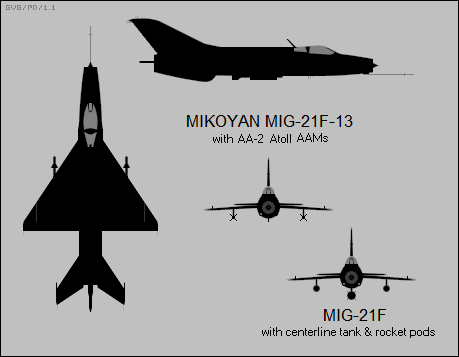
The number of fuel tanks in each wing was also increased from two to four, giving a total of 14 fuel tanks, with the wing fuel tank capacity increased in later production to provide a total internal fuel capacity of 2,470 liters (652 US gallons) -- though in practice, trim problems limited internal fuel capacity to 2,340 liters (617 US gallons). Provision was added for an enlarged centerline external fuel tank with a capacity of 800 liters (211 US gallons), as well as for a camera that could be fitted aft of the nosewheel bay to provide a limited reconnaissance capability. NATO assigned the MiG-21F-13 the reporting name of "Fishbed-C".
___________________________________________________________________
MIKOYAN MIG-21F-13 FISHBED-C:
___________________________________________________________________
wingspan:
7.154 meters (23 feet 6 inches)
wing area:
23 sq_meters (247.6 sq_feet)
length (no probe):
13.46 meters (44 feet 2 inches)
height:
4.125 meters (13 feet 6 inches)
empty weight:
4,871 kilograms (10,624 pounds)
normal loaded weight:
6,850 kilograms (15,101 pounds)
MTO weight:
8,625 kilograms (19,015 pounds)
max speed at altitude:
2,175 KPH (1,350 MPH / 1,175 KT)
service ceiling:
19,000 meters (62,340 feet)
range:
1,420 kilometers (880 MI / 765 NMI)
___________________________________________________________________
* Some of the early production Ye-6T (MiG-21F) machines were modified for trials. Modifications of the Ye-6Ts included addition of a fuel tank behind the cockpit, with a redesigned rear cockpit fairing; fit of an uprated R-11F2-300 engine; fit of a belly Dushkin liquid-fuel rocket booster, with the aircraft modified with twin ventral fins to permit the rocket's installation; and canard fins fitted to the nose, a scheme that didn't work out very well. A rocket-boosted Ye-6/T with the R-11F2-300 engine set a world altitude record of 34,714 meters (113,891 feet) on 28 April 1961, with Georgiy Mosolov at the controls. The machine was given the cover designation of "Ye-66A" for the record books.
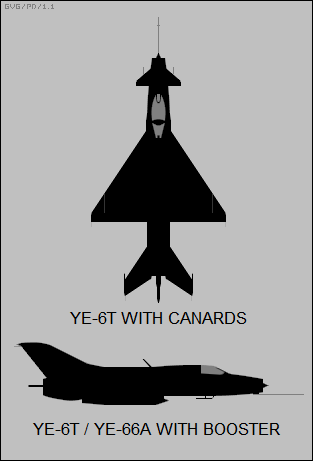
* Although the Soviets were sometimes reluctant to export their latest weapons, they had little hesitation about handing out the MiG-21. The first export machines were rolled out from the Znamya Truda factory in the summer of 1960. The Czech Aero Vodochody (pronounced "vodo-kody") factory in Prague obtained a license to build the MiG-21, with Czech production designated "S-106". It was effectively a MiG-21F-13, except that the transparent panel on the rear cockpit fairing was deleted, since it hadn't proven useful in practice. It would be deleted in later Soviet production as well. The Czechs built 194 S-106s; they would not build any other MiG-21 variants.
BACK_TO_TOP* The MiG-21F was a "daylight only" fighter, with no real capability for night or foul-weather operations, and so it was useless for the PVO (Protivo-Vozdusdushnoi Oborony / Homeland Anti-Aircraft Defense) organization, a distinct armed service dedicated to the air defense of the USSR using surface-to-air missiles (SAM) and interceptors. Due to the sheer extent of the Soviet frontier, the PVO tended to acquire heavy long-range interceptors, like the Yak-25 "Flashlight" and its much improved derivative, the Yak-28P "Firebar", but such machines were expensive. A lighter, cheaper, less capable machine would allow the PVO to field more aircraft, assigning the cheaper machines to the defense of the western borders of the Soviet Union, where the population centers were more concentrated and long range not so important.
In late 1957, the MiG OKB began work on the "Ye-7", essentially a MiG-21F with a Sapfir (Sapphire) radar in a larger inlet cone. Three prototypes were built, with the first performing its initial flight on 10 August 1958. At least five Ye-7 evaluation machines followed the three prototypes.
Trials went well, with the type going into production at Gorkiy in June 1960, with the service designation of "MiG-21P", where "P" stood for "Perekvatchik (Interceptor)", and factory code of "I-75". However, these early machines were not regarded as really satisfactory and only a few MiG-21Ps were built, with most or all being used as development aircraft. Production of the much more satisfactory "MiG-21PF" or "I-76" interceptor began in early 1962.
The initial MiG-21P had featured the production RP-21 Sapfir (NATO Spin Scan-A) radar, armament of two AA-2 Atoll AAMs (no cannon), bigger and redesigned forward airbrakes, a simple autopilot, provision for fit of twin rocket-assisted take-off (RATO) boosters along the rear fuselage, and larger tires in (as it turned out, prudent) expectation of future weight growth. The "fat" tires meant more prominent gear fairings in the top of the wing and in the gear doors. Avionics improvements a TACAN-type beacon navigation receiver known as KSI, and a Lazur (Azure) link to the Vozdukh-1 (Air-1) air defense ground network.
Although the MiG-21P lacked cannon, it did have a simple optical sight for use with underwing unguided rocket pods. The pitot tube was moved from under the nose to the top of the nose, and the pivot was eliminated. Later production featured a broader tailfin -- in hopes of making sure the aircraft flew straight so it and didn't suffer from engine stalls -- and the brake chute moved from under the exhaust to a conical-tipped fairing under the tailfin. Eventually, a more effective cruciform parachute would be introduced to take advantage of the higher position, replacing the original circular parachute. The MiG-21P was assigned the NATO reporting name of "Fishbed-D".
The MiG-21PF improved on the MiG-21P by adding two fuselage fuel tanks behind the cockpit -- as a follow-up to the scheme tested on the Ye-66 -- resulting in a distinctive "fat" rear cockpit fairing, and a fuel capacity of 2,750 liters (726 US gallons). The MiG-21PF also added the uprated R-11F2-300 engine, which provided 38.7 kN (3,950 kgp / 8,710 lbf) dry thrust and 60.0 kN (6,120 kgp / 13,490 lbf) afterburning thrust. The variant was assigned the NATO reporting name of "Fishbed-E".
* The additional thrust provided by the R-11F2-300 engine seemed adequate to support a feature known as "flap blowing", in which engine bleed air was directed over the flaps to permit lower take-off and landing speeds. It was effective but required plenty of engine power, since flap blowing robbed the engine of thrust at take-off, when the thrust was needed the most. The scheme was flowed into production in 1964, with the new variant designated the "MiG-21PFS", the "S" standing for "slovo pogranichnovo sloya (SPS)", which just meant "blown flaps"; the factory code was "I-94". The MiG-21PFS actually featured an R-11F2S-300 engine, which differed from its predecessor by incorporating a two-stage afterburner.
However, OKB engineers had more tricks in store, and only a handful of MiG-21PFS machines were built, with production flowing in turn to the further improved "MiG-21PFM" by the end of 1964, retaining the "I-94" factory code. It featured an even broader tailfin -- as big as it would get, incidentally -- and a new RP-21M radar (NATO Spin Scan-B), which supported carriage of radar-guided AAMs. Initially, the standard radar-guided AAM was the K-5 / R-2 AAM, known to NATO as the "AA-1 Alkali", but this was replaced by the much better K-13R / R-3R AAM, known to NATO as the "AA-2-2 Advanced Atoll" -- based on the AA-2 Atoll, but with a semi-active radar homing seeker.
In addition, by that time the decision to delete the cannon armament had been reconsidered and judged too hasty, and so the MiG-21PFM could be fitted with an optional belly Gryasev-Shipanov GSh-23 23-millimeter cannon pack mounted on the centerline hardpoint, with 200 rounds of ammunition carried in the pack. The GSh-23 was an ingenious weapon, featuring twin barrels that operated in a "teeter-totter" fashion, the recoil from one barrel throwing it back to actuate and fire the other barrel moving forward. It could support a rate of fire of 3,600 rounds per minute. An improved PKI gunsight was added to support the cannon pack. Other improvements included a new Khrom-Nikel SRO-2M IFF and Sirena-3M RWR.
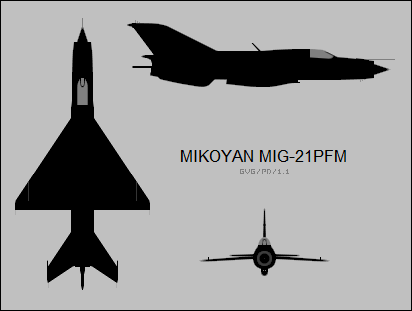
Later MiG-21PFM production featured a new ejection seat, the KM-1. It wasn't a modern "zero-zero" ejection seat, capable of working safely if the aircraft was just sitting on the runway, but it could be used at zero altitude if the aircraft was moving at a minimum speed of 130 KPH (80 MPH) and was a big improvement over the SK seat. A new two-piece canopy scheme was introduced along with the KM-1, with the canopy hinging open to the right instead of hinging forward -- the designers having given up on using the canopy as a blast screen. The new canopy arrangement cut into the fuselage fuel capacity slightly. NATO assigned the MiG-21PFS and MiG-21PFM the reporting name of "Fishbed-F".
* In service, the new MiG-21 interceptors were well-received, providing a more sophisticated weapons system with greater range and, with flap blowing, better take-off characteristics. The Sapfir radar only had a range of about 10 kilometers (6 miles), meaning that the aircraft was almost completely dependent on the ground-control network, but that was regarded as perfectly acceptable, indeed part of PVO air-defense doctrine.
MiG-21P-series interceptors were built at the Znamya Truda factory for export. North Vietnam obtained a unique "tropicalized" variant, the "MiG-21PF-V", with systems conditioned for high temperature and humidity. Export machines generally had systems to a slightly lower standard, the Soviets preferring not to spread around the latest systems since they might be compromised.
Hindustan Aircraft LTD (HAL) India license-built a downgraded version of the MiG-21PFM as the "MiG-21FL". While Indian MiG-21s carried Soviet-designed AAMs, they were also qualified to carry the French Matra Magic heat-seeking AAM. They did not carry the Magic on any regular basis, but the Indian Air Force wanted to make sure that it could be used in a pinch if stocks of other AAMs were low.
BACK_TO_TOP* While the Mikoyan OKB worked on the interceptor variants, the OKB also worked on a tactical reconnaissance variant for the Red Air Force's "Frontal Aviation (FA)" component. The starting point was the kit of Ye-7 concepts being developed for the interceptors. The idea was to fit a centerline reconnaissance pod, with different pods developed to support a range of missions. That meant the centerline external tank would have to go. In order to make sure that the aircraft got its fair share of fuel, two new underwing pylons were to be added, for a total of four, and all were to be plumbed to carry external tanks -- with the inner pylons wired for AAMs as before.
One of the Ye-7 interceptor development aircraft was modified as the initial reconnaissance prototype, the main change being the four-pylon wing. The type went into production in 1964 at Gorkiy as the "MiG-21R", where "R" stood for "Razvedchik (Reconnaissance)", with export machines designated "MiG-21RF". The OKB referred to it as the "I-94R". Series aircraft were delivered from 1965 into 1971. NATO assigned it the reporting name of "Fishbed-H".
In its production configuration, the MiG-21R incorporated enough changes to be thought of as a "second generation" MiG-21. The most noticeable difference was a new "fat" spine that ran all the way back from the cockpit to the tailfin, allowing accommodation of avionics and additional fuel, with internal fuel storage increasing to 2,800 liters (739 US gallons). The MiG-21R featured the definitive broad tailfin introduced on the MiG-21PFM, with the brake chute at the base of the tailfin. It was fitted with the R-11F2S-300 engine and had the blown flaps scheme; it retained the two-piece canopy, KM-1 ejection seat, and fat tires introduced in MiG-21 interceptor development.
One interesting and useful new feature was an angle-of-attack (AOA) sensor, This looked like a spindle fairing merged into the left side of the aircraft's nose, just behind the engine intake, with a weathercock in the middle of the fairing. The weathercock was linked to a cockpit indicator that told the pilot the angular difference between the airflow and the aircraft centerline. To accommodate the sensor, the pitot tube was offset to the right side of the nose. An improved, more capable autopilot was fitted as well. The fat spine of the MiG-21R resulted in a very poor rearward view, and so starting in 1969, MiG-21Rs were retrofitted with a rear-view periscope.
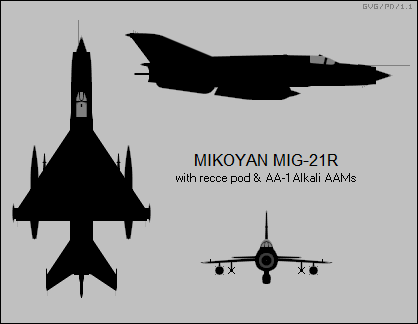
A wide range of reconnaissance packs could be carried:
All the packs could be fitted with chaff-flare dispensers and, it seems, other countermeasures systems. A typical operational configuration was a tank on each outer pylon and an AAM on each inner pylon, and up to five tanks -- the centerline pylon was still "wet", and could carry a tank if a reconnaissance pod wasn't fitted -- carried on ferry missions, though this was an unusual configuration at best. The GSh-23 cannon pod developed for the MiG-21PFM could also be carried, but that was rarely if ever done.
A specialized version of the MiG-21RF was built at the Znamya Truda factory for the Egyptians. This subvariant featured a fuselage reconnaissance pack, installed in the belly under the cockpit, carrying three film cameras arranged to give panoramic imagery. A standard MiG-21R could be easily converted to this configuration.
* Since the MiG-21R retained complete combat capability even if it wasn't actually used in practice, it was an obvious next step to produce a new fighter variant based on its updated airframe. After evaluation with prototypes designated "Ye-7S", the updated fighter was put into production at Gorkiy in 1965 as the "MiG-21S", or "I-95" as the Mikoyan OKB referred to it. It remained in production until 1968.
Aside from the new airframe, the MiG-21S featured some new kit, including a more powerful RP-22 Sapfir (NATO Jay Bird) radar with range at least doubled; an ASP-PF gunsight for the optional GSh-23 centerline cannon pod; and a link for the Lazur-M ground-control system. It could carry a range of heat-seeking or radar-guided AAMs, as well as rockets or bombs. Early on, the MiG-21S was qualified for carriage of a tactical nuclear weapon on the centerline pylon. The AOA sensor, the offset pitot tube, and the periscope were added in later production.
Although the MiG-21R and MiG-21S incorporated many improvements, the weight increase meant that ceiling and climb rate suffered. Worse, the hoped-for range increase to be provided by increased fuel capacity didn't materialize, mostly due to fuel trim problems that made the expanded fuel capacity something of a fiction. Obviously the design needed further rethinking, but that was going to take time and effort.
In the meantime, incremental improvements would have to do. An export version of the MiG-21S, the "MiG-21M" or "I-96", was built at the Znamya Truda factory from 1968 into 1971. It retained the older RP-21M radar, but featured a GSh-23L twin-barreled cannon in a flush belly installation, replacing the centerline GSh-23 cannon pod introduced on the MiG-21PFM. The flush cannon pallet carried a store of 200 rounds of ammunition and could be neatly winched out of the fuselage for servicing. The new cannon scheme not only reduced drag, but permitted carriage of a fuel tank or other store on the centerline pylon. A steel blast panel was installed on the belly of the aircraft forward of the cannon muzzles. HAL of India license-built the MiG-21M, with initial production delivered in 1973.
* A more significant advance was development of a better engine, the Tumanskiy R-13-300, a substantially improved derivative of the R-11 series, with 39.9 kN (4,070 kgp / 8,973 lbf) dry thrust and 63.7 kN (6,490 kgp / 14,310 lbf) afterburning thrust. The R-13-300 was generally mechanically compatible with the R-11 series and so it was a straightforward fit to the MiG-21S, the result being the "MiG-21SM" or "I-15". Except for the more powerful engine, as well as fit of the flush GSh-23L cannon, the MiG-21SM was much like a late-production MiG-21S.
The MiG-21SM was heavily produced at Gorkiy from 1968 into 1974. An export version, the "MiG-21MF" or "I-96F", this time retaining the long-range RP-22 radar, was put into production at Znamya Truda in 1970. HAL of India built a similar variant with the R-13-300 engine, but retained the MiG-21M designation.
BACK_TO_TOP* Mikoyan OKB engineers kept on tweaking the enlarged spine introduced on the MiG-21R, coming up with a bulged configuration that raised total fuel capacity to 2,950 liters (778 US gallons) -- they had originally performed the redesign to provide 300 liters (79 US gallons) more, but flight tests suggested that was too much, leading to fuel trim problems. The spine was so big that it gave the aircraft a "humpbacked" appearance and, unlike earlier MiG-21 variants, merged back into the brake chute fairing at the base of the tail.
The result was the "MiG-21SMT" or "I-50", which went into production at Gorkiy in 1971. Except for the bulged spine, it was much like a late-production MiG-21SM, with the latest in avionics and the R-13-300 engine. The engine fit still didn't provide enough thrust to keep up with the MiG-21SMT's weight growth, and in fact the MiG-21SMT was something of a disappointment, being built in limited numbers. Operational experience suggested that the swollen spine was another exercise in futility because trim problems once again meant all the fuel capacity couldn't be used. The Znamya Truda plant built 15 examples of an export version of the MiG-21SMT designated the "MiG-21MT" or "I-96T" in 1971, but they never left the country.
* What was really needed was a new, better engine. By that time, the Tumanskiy engine OKB had introduced the R-25-300, which provided 40.2 kN (4,100 kgp / 9,040 lbf) dry thrust and had a two-stage afterburner, with 69.6 kN (7,100 kgp / 15,650 lbf) in normal afterburning and 95 kN (9,690 kgp / 21,355 lbf) in a special combat afterburning mode that could be engaged for up to three minutes. The R-25-300 was more optimized for low-level operation than its predecessors -- combat experience showed that the original design concept, in which the MiG-21 was envisioned as fighting at high altitudes, was not the way things worked in the real world -- and less susceptible to stalls and flame-outs.
The original idea was to re-engine existing late-model MiG-21s with the R-25-300, but Mikoyan OKB engineers decided to use it on a new variant, the "MiG-21bis" or "I-75". The suffix "bis" is from the Latin / French, meaning "encore" or "again"; in terms of Western aircraft designations, the most appropriate if not literal translation of MiG-21bis is probably "MiG-21plus".
The result was not just an old MiG-21 fitted with the new engine, but a true third-generation MiG-21, since the OKB engineers used the opportunity to perform an extensive redesign on the whole machine, and this time they wanted to get it right. Externally, the MiG-21bis resembled the MiG-21SMT, but since the MiG-21SMT's fat spine had ended up providing more space than could be used, the spine on the MiG-21bis was more similar to that on the MiG-21SMT's predecessors -- with less volume, fat up front but tapering towards the rear, not merging into the brake-chute fairing as it did on the bloated MiG-21SMT. The internal fuel capacity was 2,880 liters (760 US gallons) -- and all of it was actually usable.
The airframe was largely redesigned using new alloys, resulting in a stronger but lighter aircraft. The latest avionics were fitted, including an improved RP-22 radar that provided "look-down" capability to spot targets flying near the ground; an RSBN-6S short-range navigation system and coupled instrument landing system that permitted operations in very poor visibility conditions; and a "built-in test" system to simplify maintenance. Weapons loads included the flush-mounted GSh-23L cannon, AAMs, and unguided air-to-ground stores, usually unguided rocket pods.
Typical AAM stores included the AA-2-2 Advanced Atoll, but by the era of the MiG-21bis the AA-2 Atoll had been replaced by a much improved short-range heatseeking AAM, the K-60 / R-60, known to NATO as the AA-8 Aphid. The Aphid was very agile, lethal, and lightweight; two could be carried on a single pylon using a dual-stores adapter, giving the MiG-21bis a very nasty bite indeed.
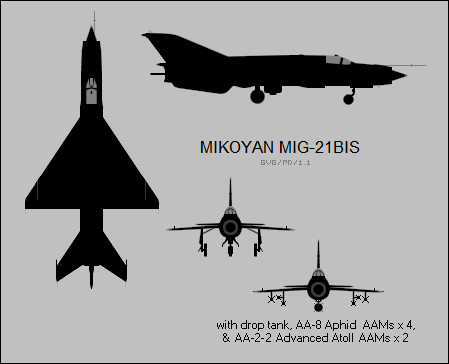
Some MiG-21bis aircraft were fitted for carriage of a tactical nuclear weapon on the centerline pylon and designated "MiG-21bisN". Early MiG-21bis production was given the NATO reporting name of "Fishbed-L"; later production featured a more complete avionics spec, with new antennas, and so NATO assigned the later machines the reporting name of "Fishbed-N".
___________________________________________________________________
MIKOYAN MIG-21BIS FISHBED-L:
___________________________________________________________________
wingspan:
7.154 meters (23 feet 6 inches)
wing area:
23 sq_meters (247.6 sq_feet)
length (no probe):
13.46 meters (44 feet 2 inches)
height:
4.125 meters (13 feet 6 inches)
empty weight:
5,895 kilograms (12,966 pounds)
normal loaded weight:
8,795 kilograms (19,392 pounds)
MTO weight:
10,420 kilograms (22,972 pounds)
max speed at altitude:
2,175 KPH (1,350 MPH / 1,175 KT)
service ceiling:
17,800 meters (58,400 feet)
range:
1,225 kilometers (760 MI / 660 NMI)
___________________________________________________________________
All 2,030 examples of the MiG-21bis were built at Gorkiy from 1972 into 1984. Soviet machines were designated "I-75P", while exports to the Warsaw Pact were designated "I-75A" and exports elsewhere were designated "I-75B". The Finns obtained some MiG-21bis fighters, and were very impressed with the type. India obtained 75 machines from the USSR, with HAL producing 220 from 1979 into 1987.
The MiG-21bis was regarded as an excellent aircraft, regaining some of the ground lost in flyability, while being far more capable. However, although there was some thought to further enhancement, by the early 1970s the design was clearly running out of steam; the Mikoyan OKB was moving on to a new design, which would emerge as the MiG-29.
BACK_TO_TOP